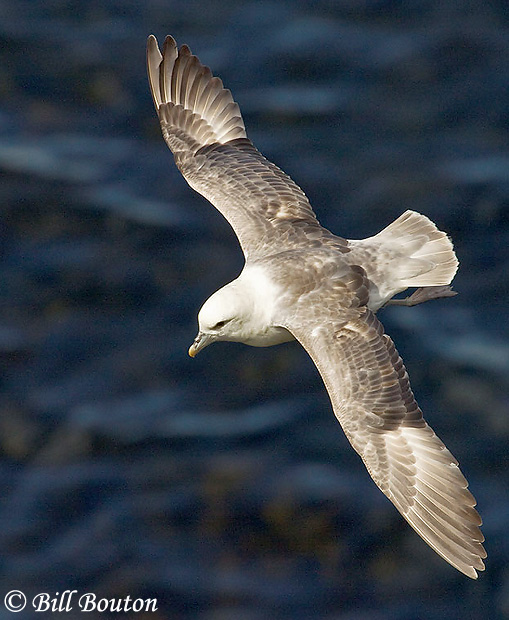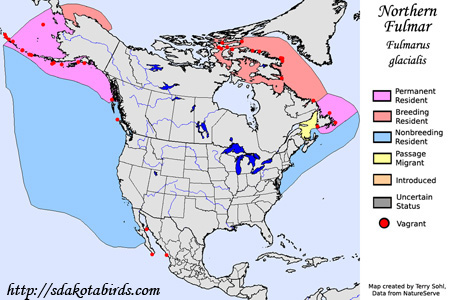Northern Fulmar
Fulmarus glacialis
| Length: 18 inches | Wingspan: 42 inches | Seasonality: Non-resident in South Dakota |
| ID Keys: Dark and light adult plumages. Dark is dark gray overall, light is white with gray wings and back. Stubby bill. | ||
 The
Northern Fulmar is a common seabird found off both coasts of North America.
They are generally a cold-water species, breeding on rocky islands in the
Arctic, and using cold ocean waters for foraging at other seasons. The
southern Hemisphere counterpart, the Southern Fulmar, and the Northern
Fulmar are the only two members of the Fulmarus genus, although
they are closely related to another "tube-nosed" group of birds, the
Petrels.
The
Northern Fulmar is a common seabird found off both coasts of North America.
They are generally a cold-water species, breeding on rocky islands in the
Arctic, and using cold ocean waters for foraging at other seasons. The
southern Hemisphere counterpart, the Southern Fulmar, and the Northern
Fulmar are the only two members of the Fulmarus genus, although
they are closely related to another "tube-nosed" group of birds, the
Petrels.
Habitat: Breeds on rocky cliffs or steep rocky slopes on islands in the Arctic. Outside of the breeding season, found in cold water on the open ocean, often very far from land.
Diet: Feeds in a wide variety of sea creatures, including fish, squid, small crustaceans such as shrimp and amphipods, marine worms, fish eggs, carrion, and refuse from fishing ships and other boats. Populations may have increased in recent decades as Northern Fulmars have learned to follow fishing vessels and feed on scraps and waste material.
Behavior: Forages by either plunging down to the water's surface when prey is spotted from flight, or by swimming on the surface and grabbing items when spotted. May dive and swim short distances underwater as they pursue prey.
Nesting: The nest of a Northern Fulmar is built on a cliff ledge, or in a crevice or crack on a steep slope. When nesting on a rocky area, no nest is built, but they will sometimes build a shallow scrape nest when nesting in areas with sand or soil. The female lays one eggs, and both the male and female will help to incubate it. Upon hatching, both parents tend to and feed the youngster, with one bird typically off foraging while the other protects it.
Song: At sea, foraging flocks of Northern Fulmars make a series of laughing and grunting calls. On their breeding grounds they have a loud cackling call.
Migration: Breeds in and around the Bering Sea, and in the Arctic parts of northeastern Canada. They disperse widely after breeding, with some birds staying far to the north, as far north as the edge of the pack ice. Other birds will wander widely to sea, nd southward as far as Mexico in the Pacific and the mid-Atlantic states in the Atlantic.
Interactive eBird map: Click here to access an interactive eBird map of Northern Fulmar sightings
Similar Species: Most likely to be confused with large petrel species, but generally distinctive in range.
Conservation Status: Northern Fulmars are very common birds in much of their range, and populations have appeared to increase substantially in the last century. The IUCN currently lists the Northern Fulmar as a species of "Least Concern".
Further Information: 1) Alaska Seabird Information Series - Northern Fulmar
2) Audubon Guide - Northern Fulmar
3) BirdWeb.org - Northern Fulmar
Photo Information: Photo taken by Bill Bouton - June 7th, 2009 near Skye, Scotland - Photo licensed under Creative Commons Attribution-ShareAlike 2.0 Generic License
| Click below for a higher-resolution map |
 |
| South Dakota Status: Non-resident in South Dakota |
Additional Northern Fulmar Photos (coming soon!!)
